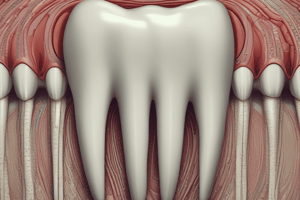Podcast
Questions and Answers
What is the approximate percentage of inorganic minerals in dentine?
What is the approximate percentage of inorganic minerals in dentine?
- 30%
- 50%
- 70% (correct)
- 90%
Which of the following is the main structural unit of dentine?
Which of the following is the main structural unit of dentine?
- Enamel prisms
- Cementoblasts
- Ameloblasts
- Dentine tubules (correct)
What is the term for the dentine located between the tubules?
What is the term for the dentine located between the tubules?
- Peritubular dentine
- Sclerotic dentine
- Intertubular dentine (correct)
- Mantle dentine
Which type of dentine is formed after the completion of root formation?
Which type of dentine is formed after the completion of root formation?
What is another name for tertiary dentine?
What is another name for tertiary dentine?
In healthy teeth, what color is dentine compared to enamel?
In healthy teeth, what color is dentine compared to enamel?
Which component makes dentine permeable?
Which component makes dentine permeable?
What is the name of the cytoplasmic extension of the odontoblast found within the dentinal tubule?
What is the name of the cytoplasmic extension of the odontoblast found within the dentinal tubule?
Which of the following is a function of dentine?
Which of the following is a function of dentine?
What is the term for the areas of unmineralized dentine?
What is the term for the areas of unmineralized dentine?
Incremental lines in dentine are called:
Incremental lines in dentine are called:
Where is the Granular Layer of Tomes found?
Where is the Granular Layer of Tomes found?
Which type of dentine forms the bulk of the tooth?
Which type of dentine forms the bulk of the tooth?
Dentine tubules near the pulp are ______ permeable than those near the DEJ.
Dentine tubules near the pulp are ______ permeable than those near the DEJ.
What is the term for calcified dentine tubules?
What is the term for calcified dentine tubules?
What is the approximate percentage of organic material in dentine?
What is the approximate percentage of organic material in dentine?
What causes dentine hypersensitivity?
What causes dentine hypersensitivity?
Which of the following best describes the shape of dentine tubules?
Which of the following best describes the shape of dentine tubules?
What is the radiographic appearance of caries in dentine?
What is the radiographic appearance of caries in dentine?
What is the term for empty dentine tubules where the odontoblastic process has retracted or died?
What is the term for empty dentine tubules where the odontoblastic process has retracted or died?
Flashcards
Dentine Composition
Dentine Composition
Dentine is composed of approximately 70% inorganic minerals (calcium hydroxyapatite), 20% organic material (collagenous matrix), and 10% water.
Dentine Tubules
Dentine Tubules
Minute tubules that permeate the dentine structure, extending from the DEJ to the border of the pulp chamber.
S-shape of Dentine Tubules
S-shape of Dentine Tubules
The path of odontoblasts during dentinogenesis.
Peritubular Dentine
Peritubular Dentine
Signup and view all the flashcards
Intertubular Dentine
Intertubular Dentine
Signup and view all the flashcards
Odontoblastic Process
Odontoblastic Process
Signup and view all the flashcards
Periodontoblastic Space
Periodontoblastic Space
Signup and view all the flashcards
Interglobular Dentine
Interglobular Dentine
Signup and view all the flashcards
Sclerotic Dentine
Sclerotic Dentine
Signup and view all the flashcards
Dead Tracts
Dead Tracts
Signup and view all the flashcards
Lines of Von Ebner
Lines of Von Ebner
Signup and view all the flashcards
Contour Lines of Owen
Contour Lines of Owen
Signup and view all the flashcards
Granular Layer of Tomes
Granular Layer of Tomes
Signup and view all the flashcards
Mantle Dentine
Mantle Dentine
Signup and view all the flashcards
Circumpulpal Dentine
Circumpulpal Dentine
Signup and view all the flashcards
Pre-dentine
Pre-dentine
Signup and view all the flashcards
Primary Dentine
Primary Dentine
Signup and view all the flashcards
Secondary Dentine
Secondary Dentine
Signup and view all the flashcards
Tertiary Dentine
Tertiary Dentine
Signup and view all the flashcards
Reactionary vs reparative tertiary dentine
Reactionary vs reparative tertiary dentine
Signup and view all the flashcards
Study Notes
Histology of Dentine
Intended Learning Outcomes
- Describe the composition and structure of dentine
- Distinguish between the 3 types of dentine: primary, secondary, and tertiary.
- Describe how the structure of dentine relates to its function
- Apply knowledge to interpret the clinical significance of dentine in health and disease
Tissues of the Teeth
- Enamel, dentine, pulp, cementum, bone (alveolar), periodontal ligament, and gingiva make up the tissues
Prior Knowledge
- Dentine location
- Dentinogenesis
- Embryonic origin
Composition of Dentine
- Dentine is composed of approximately 70% inorganic minerals (calcium hydroxyapatite), 20% organic material (collagenous matrix, non-collagenous matrix proteins, and lipids), and 10% water
Structural Features: Dentine Tubules
- The main structural units are dentine tubules, which are minute tubules that permeate the dentine structure
Dentine Tubules Shape
- Tubules traverse the dentine in an S-shape
- Tubules are almost straight underneath the cusps, incisal edges, and at the root tip
- They have a tapered outline, being more widely separated near the DEJ compared to near the pulp
- The odontoblasts' path during dentinogenesis reflects this pattern
Dentine Tubule Walls
- The walls of the tubules are called peritubular/intratubular dentine and are highly calcified with minimal collagen
- In contrast, the dentine in between the tubules is intertubular dentine, less calcified, and more collagenous
Odontoblastic Process
- The dentine tubule contains an odontoblastic process, a cytoplasmic extension of the odontoblast
- The periodontoblastic space surrounding the odontoblastic process is filled with fluid and is key for understanding dentine hypersensitivity
Interlobular Dentine
- Interglobular dentine are areas of unmineralized dentine (hypomineralized) that have failed to fuse together at the zones of mineralization
- Interglobular dentine is often found in the circumpulpal dentine just below the mantle dentine
Teeth and Vitamin D
- Interglobular dentine is prevalent in teeth where a vitamin D deficiency or high fluoride exposure has occurred during the maturation stage of dentinogenesis
- The structure of dentine, the dentine matrix, is normal, less mineralized, and does not include peritubular dentine
Sclerotic Dentine
- Dentine tubules can calcify, which is known as sclerotic dentine; it occurs via a physiological process of mineral deposition
- Most common in the apical third of the root and midway in the crown between the DEJ and pulp
- Amount increases with age, thus reducing permeability of dentine
Dead Tracts
- Dead tracts are empty dentine tubules where an odontoblastic process has died or retracted and is sealed off
- They result from physiological or pathological processes
- They are thought to be the first part of sclerotic dentine, increase with age, and reduce the permeability of dentine
Incremental Lines
- Incremental lines can be viewed under a microscope in dentine, similar to enamel
- They reflect the pattern of dentinogenesis laid in increments called Lines of Von Ebner
- They are very close together and difficult to visualize (4 um)
Contour Lines
- A more distinct incremental line is viewed at the interface between primary and secondary dentine and is known as the Contour Lines of Owen
- These are delineated by a change in direction of the dentine tubules
Granular Layer of Tomes
- A narrow layer of dentine with a granular appearance is called the Granular Layer of Tomes
- It is found only in root dentine beneath the cemento-dentinal junction and is more numerous towards the apex
- It is visible in ground sections only
- Thought to be a result of interference with the mineralization of dentine by the inner layer of the dental sac
Types of Dentine
- Dentine contains different heterogenous types based on location and timing of formation (dentinogenesis)
- Mantle dentine: initial formed dentine that outlines the periphery of the dentine adjacent to the enamel and cementum
- Circumpulpal dentine: The bulk of the dentine, it contains the dentine tubules and lies between the mantle and pre-dentine
- Pre-dentine (dentine matrix) surrounds the pulp chamber to enable dentinogenesis to continue throughout the tooth's life
Primary Dentine
- Primary dentine is the bulk of the dentine within the tooth and forms prior to completion of root formation
- Primary dentine is made up of both mantle and circumpulpal dentine
Secondary Dentine
- Secondary dentine formation begins after root formation is complete and it forms slowly throughout life
- It forms concentrated over the roof and floor of the pulp
- Over time, secondary dentine reduces the size of the pulp chamber, causing pulp recession
- Structurally similar to primary dentine with tubules, however, it is less regular and visible histologically
Clinical Significance: Secondary Dentine
- Secondary dentine's pattern of formation occurs over time
- As people age, the pulp shrinks, protecting itself
- More likely for carious or incidental pulpal exposure in younger teeth because of the prominent pulp horns in restorative dentistry
Tertiary Dentine
- Tertiary dentine is known as reactionary or reparative and forms in response to various stimuli
- It is usually localized to the area of stimulus
- Structure varies in accordance with the intensity and duration of stimulus, which may affect the odontoblasts if the stimulus is strong enough
- It may have tubules continuous with secondary dentine or may be irregular in arrangement
Clinical Significance: Tertiary Dentine
- Caries, attrition, and abrasion from a toothbrush are examples of stimuli that initiate tertiary dentine
Reactionary Dentine
- It is deposited by pre-existing odontoblasts
Reparative Dentine
- It is deposited by newly differentiated odontoblast-like cells from the ectomesenchyme of the pulp
- These cells may become trapped in the matrix forming osteodentine
Functions of Dentine
- The functions of dentine are to provide support and protection, communicate, and repair
Function Linked to Structure
- The dentine structure is rigid (70% mineralized) yet elastic (collagen 20%), therefore it can absorb shock
Dentine Functions and Structure
- Support: bulk of tooth crown and root
- Protect: rigid yet flexible
- Communicate: fluid-filled dentine tubules, proximity to pulp, odontoblastic process
- Repair: secondary and tertiary dentine
Color of Dentine
- More yellow in health compared to white enamel because it is less mineralized and absorbs more light than enamel
- In disease, it changes colors to brown
Clinical Significance: Color of Dentine
- Changes in the color of teeth are essential for detecting disease and reassuring health
Permeability
- Affected by the dentine tubules and organic matter within them
- The permeability structure varies
- Tubules at the EDJ are least permeable because they have smaller diameter
- Those above the pulp are more permeable because they have wider diameter
Progression of Caries
- Quicker and more extensive
Innervation of Dentine
- "Porous" tubules allow communication with the pulp
Communication Via Dentine Tubules
- Communication with the pulp is enabled by the tubules and odontoblastic processes
- Sensations are triggered and it can 'feel'
- This has clinical implications for restorative procedures without local anesthetic and dentine hypersensitivity
Fluid in Dentine Tubules
- Movement of fluid triggers dentine hypersensitivity
- Implicated in restorative procedures for etching and bonding plastic materials to dentine
Radiographic Appearance of Dentine
- Visibly distinct as a radio-opaque structure
Radiographic Appearance of Caries in Dentine
- In disease, once caries has reached the dentine, it becomes more visible radiographically as a radiolucent area in dentine
Studying That Suits You
Use AI to generate personalized quizzes and flashcards to suit your learning preferences.





